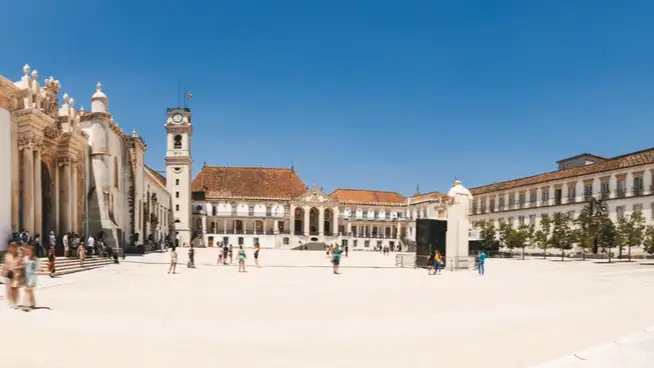Two hours north of Lisbon lies Portugal’s former capital, Coimbra, home to one of the oldest continually operating universities in Europe. Located in the building that housed Portuguese monarchs from the 12th to the 15th centuries, Coimbra University is the heartbeat of this vibrant city of culture.
With a population of 107,000 spread over 123 square miles, Coimbra is a busy metropolis, yet it retains the mellow undertone that Portugal is famous for. The university is situated high on a hill, in what is aptly named the Alta, or high, district. Descend the steep and narrow streets to the lower area of the Baixa, and you’ll discover a maze of serpentine alleys where shops are packed tightly side by side, outdoor tables display linens, pottery, and scarves, and flower stalls add bright splashes of color amid the neutral tones of the stone of the medieval city.
Retire in Coimbra

The climate in Coimbra is temperate. August is the hottest month, with an average of 73 F, and January is the coldest, averaging 51 F. January is also the wettest month, delivering about six inches of rain. If you’re interested in beach time in the summer months, just head west to Figueira da Foz, which has an active expat community.
Without a doubt, this is a city in which you can get by in English only. Between tourism and the youthful student population, being able to speak Portuguese is not a requisite to enjoying all Coimbra has to offer.
Home improvement centers like Leroy Merlin offer everything you need for your new lodging should you decide to move here, and malls like Coimbrashopping, Forum Coimbra, and Alta Shopping await. For groceries, in addition to the usual supermarkets (hipermercados) such as Continente, InterMarché, and Pingo Doce, a bonus in Coimbra is the existence of SuperCor, El Corte Inglés’s gourmet market.
Getting around by car is simple. Roads and streets are well-marked, and parking is generally ample, wherever you’re going in town. But you don’t need a car. Travel by bus, train, or taxi, and of course, Uber, as always, is a great option. You can travel to Lisbon, Porto, and other destinations by train or bus as well.
Lifestyle in Coimbra

As mentioned above, Coimbra is a city brimming with history and culture. Your day might bring you to the National Museum of Machado de Castro on Largo Doutor José Rodrigues in the Alta, a block from the University. The building is a former bishop’s palace, built in the Middle Ages over the Roman forum of Aeminium, which is, in fact, the Roman name for Coimbra. Subterranean galleries below and art collections above will fill your senses.
Or perhaps your morning may begin with a simple walk in Parque Verde. Stroll along the ribbon of the River Mondego that runs through the city, stop for lunch at a riverfront café and consider a shopping expedition to one of those malls. Or go to the Baixa where you can cruise the pedestrian walkway at Rua Ferreira Borges and Rua Visconde da Luz. Pause and enjoy traditional Portuguese pasteis de bacalhau—little cod cake pillows stuffed with mashed potatoes and parsley—or a creamy cup of gelato.
Fado is the traditional music form of Portugal, and other than Lisbon, there’s no place better to hear it than here in Coimbra, where it is only sung by men and plays a big part in University life. At Fado ao Centro, you can visit during the day, catch a rehearsal in the late afternoon, or see a performance at 6:00 p.m. That’s one of the nice parts about living in the center of the country, as opposed to Lisbon or Porto: you won’t have to wait until 9 p.m. or 10 p.m. at night to enjoy entertainment.
Cost of Living in Coimbra

Real estate prices in Coimbra are surprisingly affordable, given all that this magical place has to offer. For example, 10 minutes from the city center, you can find a three-bedroom, fully furnished apartment on a one-year lease for as little as $1,000 a month.
As everywhere in Portugal, you can find breakfast at a café for a couple of dollars, lunch (soup, main dish, dessert, drink, and coffee) for about $11, and a range of dinner prices. At the highly rated (and hard to get into) Zé Manel dos Ossos on Beco do Forno 12, for instance, menu items run from $8 to $24. At the equally popular Dux Taberna Urbana, where tapas, suckling pig, and chocolate mousse are on the menu, items range from $11 to $28.
Here’s a sample monthly budget for two. A single person can expect to cut a third off this sum.
| Expense | US$ |
| Housing (rent for a furnished two-bedroom apartment) | $975 |
| Electric | $46 |
| Water | $23 |
| Domestic Gas/Oil | $35 |
| Household Help (maid twice a month, three hours per day) | $52 |
| Internet Package (includes cell phones and TV) | $69 |
| Health Insurance | $112 |
| Transportation | $200 |
| Groceries (supermarket and farmers' market, including wine and beer) | $460 |
| Entertainment (dining out once a week, movies twice a month) | $290 |
| Incidentals | $230 |
| Monthly Total | $2,492 |
10 Things to Do in Coimbra

It would be a shame to shortchange your Coimbra adventure by allotting only a single day to the city. Here are ten reasons why.
1. The Alta—the upper region of the city—is home to the UNESCO World Heritage University of Coimbra, famed for its Joanine Library. King João V ordered construction to begin in 1717 on the magnificent three-story structure, built over a medieval prison. Among its features are a resplendent Baroque coat of arms, carved bookshelves, a painted ceiling, and splashes of gold detail to delight the senses. It houses thousands of volumes dating from the 15th to 19th centuries—ticket and appointment times are required in advance.
2. The Machado do Castro Museum is located on Largo Doutor José Rodrigues, about five minutes from the university. Built on the site of a Roman forum, this former bishop’s palace holds a varied collection of archaeological finds, jewelry, textiles, ceramics, and Portuguese and Flemish paintings. On the lowest level, you can walk among the vaulted passages of the first-century cryptoporticus featuring Roman statues. One room is devoted to 13 life-sized terracotta figures of the Apostles, created by French sculptor Philippe Hodart in 1534.
3. Coimbra’s well-maintained Botanical Gardens belong to the University and date from 1772. If flora is on your “must-see” list, consider a visit here for the landscaped areas, rare and exotic plant species, a greenhouse dating from 1859, and a bamboo grove. Peaceful fountains and statues are scattered through the gardens, which are accessed through a gate by a 16th-century aqueduct.
4. Opposite the Botanical Gardens is an elegant 19th-century mansion where Dr. Bissaya Barreto, professor of medicine at the University, surgeon, scholar, and art collector, lived for almost 50 years. Casa-Museu Bissaya Barreto is a treasure trove of Portuguese sculpture, Chinese porcelain, and fine furnishings that give an excellent idea of the life of a prominent social figure of the time. The well-maintained gardens, which also feature sculptures, are visible without gaining entrance to the house.
5. Dating from 1117, the Sé Velha (“Old Cathedral) is where the second king of Portugal, Dom Sancho I, was crowned in 1185. Built in the Romanesque style, Gothic-style cloisters were added in 1218, and 16th-century additions added a Renaissance flair. Inside, a gilded Gothic altarpiece created by Flemish sculptors is featured. Outside, the cathedral’s steps are the site for the annual “serenade” that marks the end of the academic year, as male graduates sing traditional fado in a farewell to the University.
6. In the lower region of Coimbra, the Baixa, the Santa Cruz Church and Monastery is packed with history. It has changed since its Romanesque origins in 1131 due to a major restoration in the 1500s. Here amid that Gothic influence and extensive blue-tiled panels lie the remains of Portugal’s first two kings, Dom Afonso I and Dom Sancho I. Next door is the former chapel of the monastery, now a fine European caféfeaturing stained glass, a high-vaulted ceiling, marble table tops, and leather chairs.
7. You can learn about how Coimbra’s original city walls protected it at Núcleo da Cidade Muralhada. On Tuesday through Saturday from 10 am to 1 p.m. and 2 to 6 p.m., you can see a film explaining the design for a nominal fee and walk around the Almedina Gate Tower for splendid city views and a revealing look through glass flooring at the street below.
8. It’s hard to visit Coimbra without hearing the tragic love story of Pedro I and Inês de Castro. Her death was ordered in 1355 by Pedro’s father, King Afonso IV. A classic tale of royal love, murder, and revenge, Quinta das Lágrimas (“Estate of Tears”) is where the lovers often met, and today you can stay in the 18th-century palace there, now a member of the “Small Luxury Hotels of the World.”
9. Penedo de Saudade is where legend has it Pedro I would often go to mourn the loss of his beloved Inês. Originally known as “Stone of the Winds,” and not far from the Botanical Gardens, it offers splendid views of the city. Of particular note are poems left by University of Coimbra students, inscribed on stones, as tributes to the university and the city itself.
10. Fado ao Centro is located in the historic district. Each evening at 6.00 p.m., a live performance followed by a glass of port and the opportunity to meet the performers offers a unique experience to those seeking to truly taste the culture of Coimbra.
Bonus tip: For a decidedly untouristy break, head to Pet and Tea at Rua João Cabreira, 4, to sip a beverage, enjoy a feline fix, and maybe even adopt a furry friend.
Day Trips from Coimbra

If you’ve checked out a number of things to see in Coimbra, you may not yet want to check out of your hotel. There is plenty to see nearby.
Conímbriga
This walled, former urban settlement was already established when the Romans began to arrive around 139 BC. The site of one of the largest excavations in Portugal, and considered the best preserved, these ruins lie just ten miles from Coimbra. Here, you’ll find ancient homes fashioned with brick columns, flowering gardens and sculpted ponds, ruined bathhouses (the largest of which has been partially restored), and a sunken shopping complex. Despite centuries of exposure to the elements, the vibrant color and detail of the intricate mosaic designs are extraordinary. At one end of the old aqueduct, near the main city gate, rows of benches fill the amphitheater, where performances are occasionally held on the raised wooden stage. A museum, gift shop, and pleasant restaurant are on the premises.
Figueira da Foz
A beach community 45 minutes from Coimbra, “Fig” is replete with restaurants and bars, shopping and leisure activities, and, not surprisingly, expats. Situated at the mouth of the River Mondego, with 21 miles of coastline, it boasts Europe’s biggest urban beach, divided into local favorites like Praia de Buarcos. In addition to its natural beauty, there is history to be enjoyed here. The Santa Catarina fortress tells its stories through the centuries, from its foundation beginning in 1385 to the current fortress dating from 1585 to its sacking in 1602 by British pirates to the occupation by Napoleon’s army in 1808. It’s a perfect place to grab a drink or meal and watch the setting sun. The town’s bullfight stadium, seating 6,000, is used not only for traditional purposes but also to host musical and other cultural events. If that doesn’t appeal, pay a visit to the luxuriously appointed Sotto Mayor Palace, built in the French style in the early 19th century.
On your way to Figueira da Foz, take time to stop at Montemor-o-Velho. A former inland port of great importance, this area was subject to a series of conquests and requests by Arabs and Christians from the 9th to 12th centuries. The castle, arguably the oldest in Portugal, is well maintained and, since 2014, has hosted the Festival Forte each August, featuring electronic music, visual and performing arts. In town, sample a queijada, for which the town is known: a sweet made of cheese, eggs, milk, and powdered sugar.
Praia Fluvial das Sete Fontes
One of the best parts of Portugal is its extensive network of river beaches. This one is open from June 15 to September 1 and offers a pool with a lifeguard (a relative rarity), two picnic areas with grilling facilities, a bar, a playground, showers, restrooms, and parking. It is located at Rua Sete Fontes 33, 3060-441 Sete Fontes, three miles from Cantanhede on N234.
Bussaco (“Buçaco”)
Here, you’ll find Portugal’s only natural forest—250 acres of it—and the remains of a Carmelite convent adorned with azulejos, cork, and colored stones. Much of the convent was destroyed in order to build the summer palace and hunting lodge commissioned in 1888 by King Carlos I. Unfortunately, it took 19 years to build, and the royal family had only a few short years to enjoy it before the overthrow of the monarch in 1910. You can enjoy it though, in the form of the Bussaco Palace Hotel. If you find the restaurant is a bit pricey, enjoy a picnic lunch at one of the many benches provided on the grounds. At the edge of the forest, be sure to visit the small spa town of Luso, famous for its healing waters, where you can fill your own bottle at the São João Fountain, with some of the purest water in Portugal.
Tomar
Less than an hour south of Coimbra is the legendary town of Tomar, founded by Portuguese crusader Gualdim Pais in the 12th century. It is home to the Order of Christ/Knights Templar Castle and Convent, which is a must-see, and the tidy town below also offers attractions of its own. The River Nabão runs through it, crossed by the lovely Dom Manuel bridge. In the Praça da República, the São João Baptista church, a monument to Gualdim Pais, and assorted eateries and shops offer an excellent way to spend your day.
These are some of the main attractions within easy reach of Coimbra, but there are other towns with more modest offerings dotted throughout the Coimbra district: Lousã with its schist villages; the castle town of Penela; Aveiro, “The Venice of Portugal,” and “The Capital of Chanfana”—Vila Nova de Poiares—where each year a week-long festival celebrates the famous goat dish, traditionally cooked in a wood oven in black clay pots with olive oil, garlic, paprika, salt, chili, and red wine.












